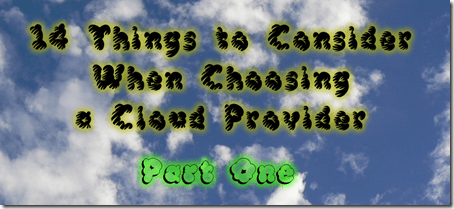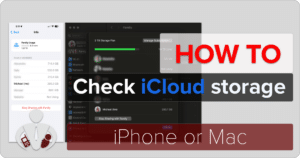You should all know by now that the cloud is here to stay. It may be in one form or another and in various flavors (infrastructure, platform or application) and it may not be called “cloud” in a few years, but the concept of on-demand, pay-as-you-go, Internet-delivery, scalable, as-a-service functionality will persist. It’s efficient, it’s cost effective and it is becoming better each and every day. However, when it comes to choosing a cloud provider, there are several things that you or your business should seriously think about before plunking down your credit card and signing up for a service.
Before evaluating a cloud provider, you need to think about exactly what you are trying to accomplish. Are you looking to replace an aging CRM system? Think about a SaaS provider. Want to enable your developers to code in whatever language they want and publish to a managed system? Consider a cloud platform offering. Or do you want to replace your data center so that you can take advantage of the scalability and cost-control that is built into the cloud? Then cloud infrastructure might be for you.
Also, depending on your organization’s needs, you may need a mixture of cloud services and that may result in having a variety of cloud providers. Just a little word of warning, while there are many standards emerging, not all cloud services are alike and just the way you would have to work on system integration with physical environments, you will have to do the same with clouds. You may have to work with different APIs or have to map business processes from one system to another. It can definitely get confusing.
But once you have focused down and identified your needs, you need to compile and short list some cloud providers. Listed below is a series of considerations when evaluating and choosing a cloud provider. Often it is hard to generalize when you span cloud types. But just the same way that clouds in general have common characteristics, your selection process should have similar requirements.
This is Part 1 of a two part blog series. Part 2 is available here.
14 Things to Consider When Choosing a Cloud Provider
First of all, these are NOT in any kind of order other than how they popped into my head. However, you might want to take this list and figure out what are the most important to your business. There are, I’m sure, plenty of things that are classified as Must-Have, Nice-to-Have and Not Important. Be sure to think it through before signing on the bottom line.
Here’s the list with details that follow:
- Performance
- Breadth of Service Offering
- Ease of Use
- Price
- Support
- SLA
- Security
- Control (Part 2)
- Reliability (Part 2)
- Reach (Part 2)
- Standardization (Part 2)
- Expertise (Part 2)
- Company Accessibility (Part 2)
- Flexibility (Part 2)
>
Let’s look at the details of the first 7 items.
1) Performance
This is almost a no-brainer. You want a cloud that has good performance, otherwise, you will lose business or customers and end up beating your head on the desk every time your application or site sputters along. The problem is, there are not many places that benchmark cloud services. It is easier to benchmark on the platform or infrastructure layer, but more difficult on the application side. And, depending on how you are using these sites, “your performance may vary.”
The best thing to do is to see if you can get a trial account. And try to see if you can test an environment that is similar to what you desire to use. Don’t test an extra small server, for example, if you are planning on running a Big Data cluster on extra-large servers. Again, I’m stating the obvious. Bottom line, be sure to test it out.
2) Breadth of Service Offering
This really depends on the type of cloud you want to use. If you are looking at SaaS, you will have to simply do a feature comparison and many SaaS companies offer comparison matrices against who they feel to be their primary competitors. A hint here, if you can’t do a 30-day trial, look for product demos, webinars or videos that show you the product in action.
If, however, you are looking at the platform or infrastructure level, the comparisons may be a bit more difficult. There are plenty of PaaS companies that focus on doing one (or two) things extremely well, while others tend to have wider capabilities. On the IaaS side, you may only be interested in raw compute, storage and networking. But vendors do vary so get that checklist out and ensure that your shortlist meets your needs.
3) Ease of Use
This also depends on who you are getting the cloud for. If it is simply developers or programmers, having complexity by means of lots of functionality, might be ok. If the feature set is so huge that it verges on overwhelming, be sure that the cloud provider has good documentation and/or support (and that you won’t be paying a fortune on Support or Professional Services). If, however, you are catering toward a non-technical end user or a wider variety of users, you may have more emphasis on the cloud solution being a bit easier to use. Know who your audience is and cater to their abilities and preferences.
4) Price
When it comes down to it, price always seems to be at the top of the list when selection priorities emerge. As I review a lot of consumer gadgets, I have developed an unwritten rule that I try to follow: don’t buy either the least or most expensive – go for the middle ground. It’s a common-sense rule. If you go cheap, you will see the weaknesses much more quickly and easily. If you choose the most expensive, you (or your CFO) will be kicking yourself for days/weeks/months/years to come.
Also, don’t primarily base your decision solely on price. You will be excluding a huge number of better solutions if you do. And more often than not, you will end up paying more later to get the features or functionality you wanted in the first place.
5) Support
While there are many developers or organizations who firmly believe in doing it yourself (DIY), when it comes to cloud computing, sometimes you really need to be able to talk to the experts of a particular cloud. That is where support comes into play. If a particular cloud provider has a stellar array of complex services, you will definitely want to investigate their support options as well. Most providers offer some sort of paid support and some offer free support as well. Also, a hidden rule of thumb, the more services you use or consume and the larger your monthly bill, the more likely you will have faster access to (better) support.
There are some providers who simply provide user forums where the support mechanism is delivered via moderators or overly-helpful end users. For the most part, when you are architecting a solution and you are not under a time crunch, this option is just fine. These natural support ecosystems can be a wealth of knowledge. However, if (and when) issues or outages start happening, the support forums may not be the best way to get your environment back up and running. When this happens, its nice to be able to pick up a phone, log a ticket or get on a support chat to quickly resolve the issues you are having.
So, when you look at a provider, find out what type of support options are available. Are they tiered? Is there a free level? What response times do you get for the different support price points? When you calculate your total cost of ownership (or usage) of a cloud, be sure to include the support pricing in the bottom line.
6) Service Level Agreement (SLA)
Going hand-in-hand with support is the Service Level Agreement. Most cloud providers have one of these. Read it. Ask questions about it. Try your best to understand it. If they don’t have one, or it is vague or very loose, be sure to probe deeper. Try to think of what-if scenarios and see how you would fare. Are the services that you will be using covered by the SLA?
Also, look to see how the cloud service performance is articulated in the SLA. Are there even performance metrics listed? What is your recourse if you experience performance outside of the SLA’s definition? And check to see if Support response time is included as well. It should be. You need to have set and realistic expectations on acknowledging and hopefully resolving any issues that you may have. Does your SLA vary based on what cloud services you have or what Support tier you are subscribed to?
7) Security
Security is one of the biggest concerns listed for the lack of adoption of cloud computing. And it should be. You want your data, your information and your environment to be a secure and protected as possible. There is a minimum level that should be acceptable, but this is determined by what your business is and the type of data contained within your cloud environment. You need to define what must be heavily secured and what minimally secured.
Because of the enhanced scrutiny of the cloud, most cloud environment have potentially better security than your own data center or infrastructure environment. Obviously, this, again, does depend on your business and if compliance is a requirement of your industry. In these cases, your short list of cloud providers may be much smaller than not. Be sure to ask your provider what options are available to provide you with a secured environment. Find out if these providers have passed security audits, when they were passed and what security measures they employ. While security definitely has gotten much better, it is not something to be overlooked.
Putting It All Together
In Part 2 of this series, I discuss the next 7 items in the list, specifically: Control, Reliability, Reach, Standardization, Expertise, Company Accessibility and Flexibility.
It’s important to remember that every business’s cloud provider selection criteria will vary based on their business and technology needs. Don’t focus on just one item and obsess on that particular item. Choose based on clearly established, discussed and agreed upon criteria, hopefully from the list that I have compiled. Selecting a cloud vendor should really be considered selecting a cloud partner, someone who will walk you down the path toward your success. And there may be some other items that I didn’t list out that may be critical to your decision process.
 This post was written as part of the IBM for Midsize Business program, which provides midsize businesses with the tools, expertise and solutions they need to become engines of a smarter planet. I’ve been compensated to contribute to this program, but the opinions expressed in this post are my own and don’t necessarily represent IBM’s positions, strategies or opinions.
This post was written as part of the IBM for Midsize Business program, which provides midsize businesses with the tools, expertise and solutions they need to become engines of a smarter planet. I’ve been compensated to contribute to this program, but the opinions expressed in this post are my own and don’t necessarily represent IBM’s positions, strategies or opinions.
HTD says: Choosing a cloud provider can be complicated. Just be sure you fully understand your requirements before signing up with one!








